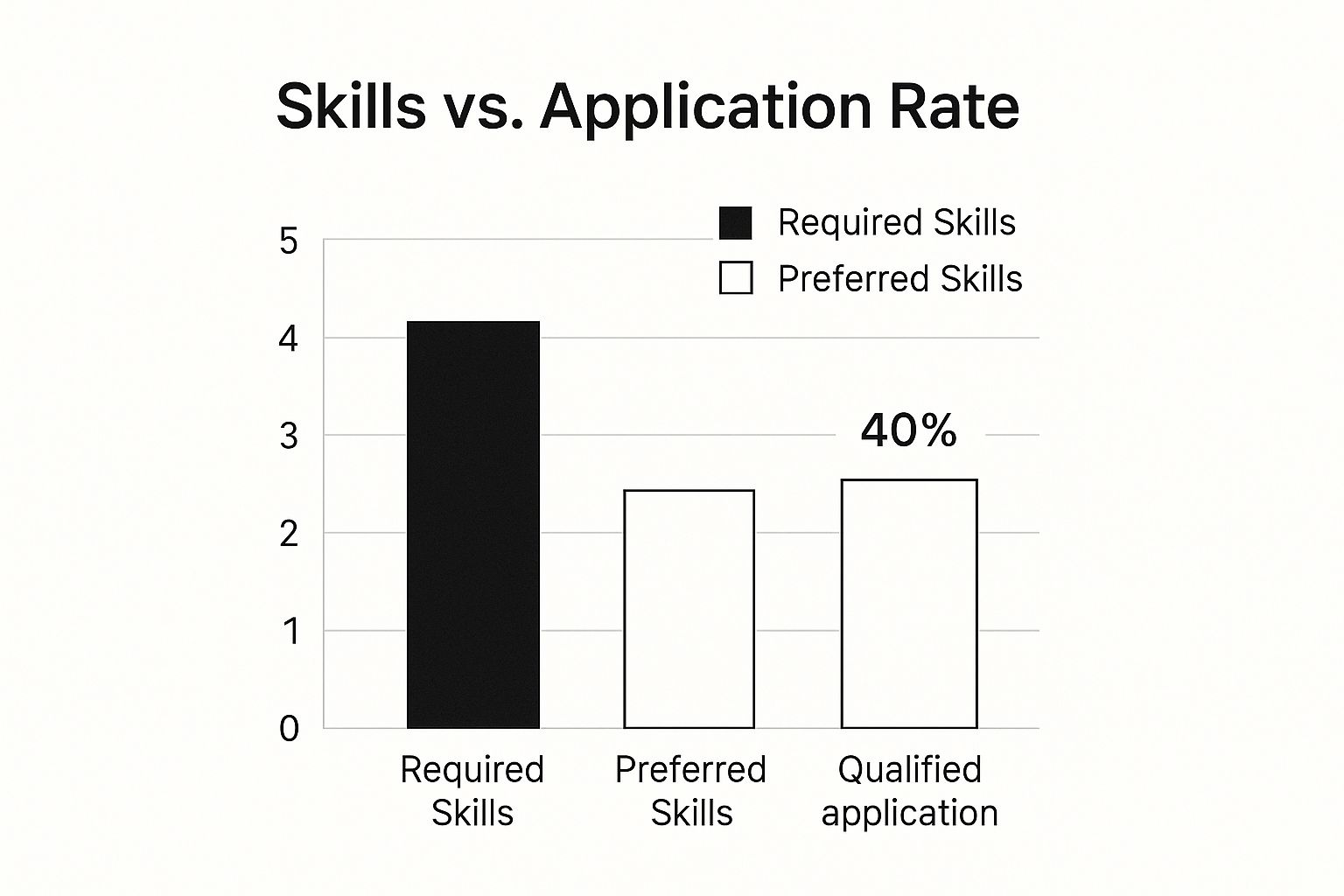Craft a Killer LinkedIn Job Posting
- Janis Kolomenskis
- Jul 7
- 13 min read
Alright, let's get down to business. Posting a job on LinkedIn isn't just about filling a vacancy anymore. It's your prime opportunity to tap into a massive global network of talented professionals, many of whom are actively looking for their next big move. Think of it less as an advert and more as a branding exercise—a chance to tell your company's story and reel in your next superstar hire.

Build an Irresistible LinkedIn Job Posting
So, you're ready to create a LinkedIn job posting that actually gets noticed? Fantastic! In a talent market this competitive, a bland, cookie-cutter job description just won't cut it. It’ll get lost in the noise. We’re going to build a post from scratch, focusing on what truly makes a role and a company magnetic to top-tier candidates.
This is more than just filling in boxes on a form. We're crafting a story. The mission? To make the best candidates stop their endless scrolling, read your post, and immediately picture themselves thriving on your team. It all starts with a killer job title and a summary that hooks them from the very first line.
Core Components of a High-Impact Job Posting
Before we dive into the fancy stuff, let's nail the fundamentals. Every truly great LinkedIn job post is built on a few non-negotiable elements. Getting these right is the absolute key to grabbing the attention of the people you actually want to hire.
To make it crystal clear, here’s a quick-reference table breaking down the essential parts of an effective posting and why each one is so critical.
Component | Purpose | Key Action |
|---|---|---|
Magnetic Job Title | Attract the right searchers | Use clear, industry-standard titles. Ditch the quirky jargon like "Growth Ninja" for something searchable like "Digital Marketing Manager (SEO/PPC)." |
Engaging Summary | Hook them instantly | This is your elevator pitch! Introduce the role, the team, and what makes your company special. Make those first two sentences count. |
Clear Role Description | Set clear expectations | Use bullet points to detail key responsibilities. Frame them around impact and achievements, not just a list of daily tasks. |
Getting this foundation solid is your first win. It ensures your post not only gets discovered by the right people but also genuinely connects with them.
It's also vital to understand the local context where you're hiring. Take Latvia, for instance. The employment rate was 71.4% in 2023, which means over a million people are in the workforce. But with ongoing economic shifts, companies need to be strategic. They have to offer competitive salaries to attract skilled talent, especially for roles in high-demand fields like business services. You can get more fascinating insights into the Latvian labour market from Eures.
A great job post isn't just a list of what you want; it's a compelling offer of what a candidate gets. It speaks to their ambitions, values, and desire for meaningful work.
Once you've mastered these basics, you’re ready for the more advanced tactics that separate a good post from a truly unforgettable one. For a deeper dive, our comprehensive guide to posting jobs on LinkedIn is packed with even more strategies to make sure your efforts pay off.
Write Job Descriptions That Resonate and Convert

Let's be honest for a second. The classic, soul-crushing list of "duties and responsibilities" is a guaranteed way to make a candidate's eyes glaze over. It's boring, it's robotic, and it tells them absolutely nothing about why they should be excited to work with you.
To really grab the attention of top talent, your linkedin job posting needs to do more than just list tasks. It needs to tell a story and spark a genuine connection. Think of your job description less like a wanted poster and more like an exclusive invitation. You're not just trying to fill a vacancy; you're inviting a brilliant person to join your journey and play a vital role in your company's future.
Paint a Vivid Picture of Your Culture
I can't stress this enough: top performers aren't just looking for a paycheque. They're searching for a place where they feel they belong, a team where they can make a real difference. Your job description is your first, best chance to paint a picture of what it’s really like to be part of your crew.
So, ditch the generic clichés like "fast-paced environment." What does that even mean? Instead, show them.
For example: "We're a tight-knit team that lives for collaboration. Picture weekly brainstorming sessions fuelled by genuinely good coffee (we’re serious about our beans!) and game-changing ideas. You'll be in the trenches with our founders, directly shaping the future of our product."
See the difference? That simple shift helps a candidate visualise themselves not just working, but thriving with you. It gets them genuinely excited to be part of your mission.
A job description that breathes life into your company culture and values will always attract candidates who aren't just a great fit on paper, but a fantastic long-term addition to your team.
Frame Challenges as Exciting Opportunities
Every role has its challenges. That's a given. But instead of glossing over them or phrasing them in a way that sounds like a warning, frame them as exciting opportunities for growth and achievement. This is how you attract ambitious, driven people who love solving tough problems.
Let's look at a quick before-and-after.
The Bad: "Must handle high-pressure situations and tight deadlines."
The Good: "You'll be on the front lines, spearheading the launch of our new flagship product. This means taking ownership of critical timelines and navigating the thrilling challenges that come with a major market release."
The second example doesn't hide the pressure, but it redefines it as a high-stakes, high-reward experience. That kind of language speaks directly to the go-getters you want on your team.
Articulate the Tangible Impact
At the end of the day, brilliant people are motivated by impact. They need to know that their work matters. Be crystal clear about how this specific role contributes to the company's grand vision and the team's success.
Connect their day-to-day responsibilities to real, tangible outcomes.
Instead of: "Manage social media accounts."
Try: "You will be the voice of our brand, leading our social media strategy to build a vibrant online community, drive meaningful engagement, and connect with thousands of our followers."
This shows candidates the bigger picture and helps them understand the incredible value they'll bring to the table. If you want to dive even deeper into this, check out our guide on [writing a job description that actually attracts top talent](https://www.yena.ai/post/writing-a-job-description-that-actually-attracts-top-talent).
By transforming your LinkedIn job posting from a passive bulletin into an active, compelling recruitment tool, you'll attract more than just applicants—you'll attract the right ones.
Get Your Job Post Seen: Optimising for LinkedIn Search

Alright, so you've hit 'publish' on your LinkedIn job posting. That's brilliant, but don't kick back just yet. Now we need to make sure LinkedIn's algorithm actually works for you, not against you. Think of it less like a job board and more like a search engine. Your mission is to give it all the right signals so it shows your role to top-tier, relevant professionals.
So, how do we do that? First, you need to think exactly like your ideal candidate. What words and phrases are they actually typing into that search bar? Forget generic job titles for a moment and focus on the specific skills, tools, and tech that are central to the role.
Nail Your Keyword Research
Keyword research sounds like something reserved for SEO geeks, but trust me, it’s a non-negotiable skill for any recruiter wanting to win on LinkedIn today. You're essentially looking for the magic words that bridge the gap between your job post and the perfect candidate.
Here's a super practical approach I always use:
Spy on the Competition (Ethically!): Find 5-10 job postings for similar roles. What are the recurring skills, software, and qualifications they mention? Jot them down. This is your starting list.
Be the Candidate: If you were a "Senior Data Analyst," what would you really search for? Probably things like "SQL," "Power BI," "Data Visualisation," or even "Python for data analysis."
Let LinkedIn Help You: Start typing in the main LinkedIn search bar. The suggestions that pop up are pure gold—they're what real people are actively searching for.
Once you’ve got your list, don't just stuff them in. Weave them naturally throughout your job title, the summary, and deep into the responsibilities section. This makes your post speak the algorithm's language and catch the eye of the right people instantly.
Your job posting is a direct conversation with LinkedIn’s algorithm. Feed it the right keywords, and it will introduce you to the best candidates.
Boost Your Reach with Skills and Team Power
Keywords are the foundation, but there are a couple more tricks up LinkedIn's sleeve you absolutely need to use.
Don't Skip the Skills Tags This one’s a biggie. When you're setting up the post, LinkedIn prompts you to add skills. A lot of people rush this part, but it’s a massive signal to the platform. Candidates are constantly matched to roles based on the skills they have listed on their own profiles. So, make sure you add a healthy mix of hard skills (like "JavaScript" or "Financial Modelling") and soft skills (like "Team Leadership").
Get Your Team to Amplify It Honestly, your own employees are your most powerful marketing tool. A simple share from a team member can explode your post's reach. So, actively encourage your crew to share the LinkedIn job posting on their own feeds. A little personal note from them about why it's a great place to work adds a layer of authenticity that no ad spend can buy. It's powerful, it's genuine, and it costs you nothing.
For an even deeper dive into these tactics, our full guide on [how to post a job on LinkedIn with strategies that work](https://www.yena.ai/post/how-to-post-a-job-on-linkedin-real-strategies-that-work) has a complete playbook waiting for you.
Supercharge Your Hiring With LinkedIn’s Advanced Features
Alright, so you’ve posted your job. But are you really making the most of what LinkedIn has to offer? Think of your job post not just as a static ad, but as a dynamic recruitment tool. LinkedIn is loaded with some seriously smart features that can slash your admin time and get you in front of genuinely brilliant candidates. Let's get into how you can turn your basic post into a high-performance hiring machine.
The real game-changer is when you let the platform automate the initial sifting and sorting for you. This is how you reclaim your valuable time and focus your energy where it truly matters: on connecting with the people who could be your next superstar hire.
Use Screening Questions to Find Top Talent Faster
Picture this: your applicant list is growing, but instead of a chaotic jumble of CVs, you see a neatly organised queue of the most qualified people. That's exactly what screening questions do for you. By setting up a few strategic, role-specific questions, you’re essentially letting LinkedIn’s algorithm do the first-round vetting.
You can add questions that automatically filter candidates based on your absolute must-haves. For instance:
Work Authorisation: Can they legally work in the country where the job is based? This is a simple yes/no that saves everyone time.
Years of Experience: Does the applicant have the minimum 5 years of experience you need for a senior position?
Specific Certifications: Does that developer you're looking for actually have the AWS certification listed as essential?
When you mark a question as a "deal-breaker," LinkedIn automatically archives applicants who don't meet the criteria. It’s a beautifully simple feature that can drastically cut down your review time, letting you jump straight to engaging with candidates who are genuinely a great fit.
Here’s a stat for you: Adding screening questions can boost your chances of finding a qualified applicant by a whopping 50%. It’s one of the easiest and most powerful tweaks you can make to your hiring process.
This isn’t just theory; the data backs it up. The right skills on your job post directly impact the quality of applications you receive.

As you can see, being selective and focusing on core, mandatory skills results in a much higher percentage of qualified applicants. Less really is more.
Free vs Paid LinkedIn Posting Features
Deciding whether to stick with a free post or invest in a promoted one can be tricky. While a free post is great for visibility, paying for a promoted job unlocks a suite of tools designed to get your role in front of more of the right people, faster. Here’s a quick breakdown of what you get with each.
Feature | Free Job Posting | Promoted Job Posting |
|---|---|---|
Visibility | Appears in search results and on your company page. | Top placement in search results and targeted notifications. |
Applicant Management | Basic tools to view and manage applicants. | Advanced filtering, status tracking, and candidate management. |
#1 Job Applicant | No | Highlights the top candidate based on your criteria. |
Targeted Audience | Limited organic reach. | Reaches both active and passive candidates via targeting. |
Analytics | Basic data on views and applicants. | Detailed insights on post-performance and candidate demographics. |
Screening Questions | Yes, you can add them. | Yes, with enhanced sorting and "deal-breaker" functionality. |
Promoting your job is an investment, but when you’re chasing top-tier talent in a competitive market, the enhanced targeting and management tools can make all the difference.
Go Beyond the CV with Skills Assessments
Let's be honest: a CV tells you what a candidate says they’ve done, but a skills assessment shows you what they can actually do. LinkedIn has a fantastic library of standardised tests—covering everything from JavaScript to financial modelling—that give you objective proof of someone's expertise.
Inviting your strongest contenders to take an assessment adds a powerful layer of validation before you even think about scheduling an interview. It’s an incredible way to confirm that the skills on paper translate to real-world ability, ensuring your shortlist is built on substance, not just slickly written resumes.
And if you really want to put your hiring on autopilot, this is where you can connect LinkedIn’s features with the power of Yena’s templates and automation. Imagine a workflow where candidates who ace a LinkedIn skills assessment are automatically moved into your "Interview" pipeline in Yena, which then triggers a personalised email to schedule a chat. That’s how you build a seamless, efficient, and genuinely impressive candidate experience that shows you’re a modern, forward-thinking company.
Analyse Performance and Adapt Your Strategy
Hitting 'publish' on your LinkedIn job post feels great, but that's just the beginning. The real work—and the real results—come from digging into the data. I've learned over the years that truly great recruitment isn't a guessing game; it's a science. When you put on your detective hat and start investigating your post's performance, you can transform a decent hiring process into a phenomenal one. Think of your LinkedIn analytics dashboard as your mission control.
So, what's happening behind the curtain? Are you getting heaps of views but only a trickle of applications? That's a classic sign of a mismatch between your killer job title and a job description that isn't quite hitting the mark. By getting comfortable with the numbers, you stop just tracking progress and start diagnosing issues before they become major problems.
Key Metrics to Keep Your Eye On
Once your job is live, don't let yourself get bogged down by every single data point. It's easy to get lost in the numbers. Instead, laser-focus on the few key metrics that tell you the most important story about your post.
Here are the heavy hitters I always track:
View-to-Apply Rate: This is the big one. If you have tons of views but a tiny number of applications, something is putting people off after they click. It could be the salary, the listed responsibilities, or even the required experience. Time to investigate!
Applicant Demographics: Are you reaching people in the right industry, location, and with the right level of experience? This tells you instantly if your targeting is on point or needs a nudge in a different direction.
Keyword Performance: LinkedIn will actually show you which search terms are leading people to your post. If the top keywords aren't what you'd expect, it's a clear signal to go back and refine the language in your job description.
Keeping a close watch on these metrics is how you build a smarter, more agile recruitment strategy. For a deeper dive, check out our guide on the [essential recruiting metrics to improve hiring in 2025](https://www.yena.ai/post/essential-recruiting-metrics-to-improve-hiring-in-2025).
Fine-Tuning Your Approach Based on What You See
Data is only powerful when you act on it. If your analytics are waving a red flag, it's time to make a change. For example, if you're not getting enough qualified applicants, could your screening questions be a little too harsh? Sometimes, a tiny tweak can open the floodgates to fantastic candidates.
Your LinkedIn analytics aren’t just a report card for one post; they're a blueprint for every single hire you make from now on. Each insight feeds into a powerful loop of continuous improvement, making your entire recruitment process leaner, smarter, and more effective.
This data-first mindset is absolutely critical in today's fast-moving job markets. Take Latvia, where forecasts show a massive shift towards professional roles in business services. It's expected that 46% of the workforce will hold high-level qualifications by 2025. This trend underscores why a well-analysed LinkedIn job posting is non-negotiable for connecting with top-tier talent. You can [explore more on Latvia's skills forecasts on cedefop.europa.eu](https://www.cedefop.europa.eu/en/country-reports/latvia-skills-forecasts-2025). Staying on top of this kind of data ensures you're always one step ahead.
Still Got Questions About LinkedIn Job Postings? Let's Clear Them Up
Alright, so you’ve got the basics down, but a few questions are still nagging at you. That's completely normal! After helping hundreds of companies with their hiring, I’ve heard them all. Let's tackle some of the most common ones so you can post your next role with total confidence.
Think of this as our little Q&A session to get you over the finish line.
How Long Should a LinkedIn Job Posting Be?
This is the million-dollar question, isn't it? The magic number is somewhere between 300 and 700 words. That’s the sweet spot. It's long enough to give candidates the crucial details they need, but short enough that you won't lose their attention while they're scrolling on their phone.
The key is how you structure that word count.
Job Title: Keep it punchy and clear. Under 80 characters is best.
Opening Summary: You've got two sentences to hook them. Make them count!
Responsibilities & Skills: Always, always use bullet points. They’re your best friend for making the core requirements easy to scan and digest.
Remember, you're not writing a novel. You're creating an advert that needs to grab attention and make someone think, "Wow, I need to apply for this."
What Are the Biggest Mistakes to Avoid?
Oh, I've seen some doozies over the years. It’s often the small, avoidable things that can completely derail a great job post. Knowing what not to do is just as important as knowing what to do.
The number one mistake? Using quirky, internal job titles. Your team might love calling someone a "Growth Ninja," but trust me, nobody is typing that into the LinkedIn search bar. Stick to clear, universally understood titles that top talent is actually looking for.
Another classic blunder is the ridiculously long "must-have" list. When you list 20 different qualifications, you risk scaring off fantastic people who meet 80% of your criteria but feel intimidated. And please, don't forget to talk about your company culture! It’s a huge part of what makes a job a great fit.
Here's a hard truth: if your job posting isn't mobile-friendly, it might as well be invisible. A huge number of candidates browse on their phones, so short paragraphs and scannable lists aren’t just nice to have—they’re essential.
Should I Include the Salary in My Job Posting?
Yes. A thousand times, yes! If you can, you absolutely should. The data from LinkedIn itself is overwhelming: job posts with a salary range get significantly more applicants. It's really that simple.
Think about it. Including a salary range is a sign of respect for a candidate's time. It instantly tells them whether the role is a viable option and filters out those whose expectations don't align with your budget. This saves everyone a ton of time and leads to a pipeline of candidates who are genuinely serious about the opportunity.
Honestly, it’s the fastest way to build trust and start the relationship off on the right foot.
Ready to stop wrestling with job descriptions and start delighting candidates? Yena provides beautiful, pre-built templates and AI-powered automation to make every LinkedIn job posting a success. Launch your professional careers page in minutes and see why over 500 SMBs trust us to hire smarter at https://yena.ai.

Comments